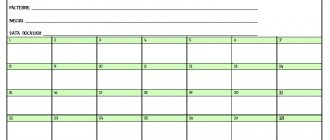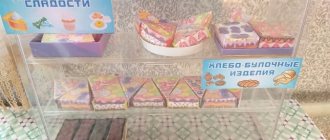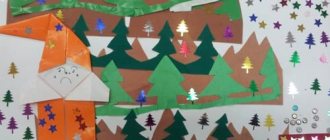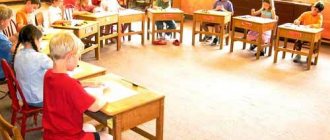Set 7 - Colored figures
A large organizer contains flat shapes: triangles, squares, circles and semicircles. They are made in different colors and are small in size. From these elements you can assemble different designs. They are used as counting material.
Guidelines for kit 7
Recommended age: 5-6 years. A set with colored figures gives free rein to creative tasks. Suitable for both individual and group lessons.
- The kit allows you to transfer a three-dimensional image into two-dimensional space. You can give children the task of creating a certain composition from the proposed figures, starting with a simple one (flower, house, car, etc.) and ending with complex themes.
- To repeat shapes and colors, you can sort the figures, for example, by red color or fold the triangles separately. Over time, the task becomes more complicated and combines several sorting categories at once - yellow circles, white squares, etc.
- As a thinking exercise, children connect the figures and talk about the new shapes they get.
What does it contain?
- Triangles.
- Squares.
- Circles.
- Semicircles.
Set 12 – Mosaic, lacing
The original mosaic from Froebel is distinguished by the presence of colored ropes that can be used to connect different pieces. From them you can collect different images: from simple to complex. The parts are rounded and therefore safe. They fit tightly into the base and do not fall out of it. You can connect only chips of the same color with ropes or create a pattern with them.
Guidelines for kit 12
Recommended age: 2-3 years. The basis of any games with lacing is the sensory development of children.
- The child’s task is to make a picture named by the teacher from multi-colored chips.
- Using strings, you can lace the board through the holes. The game will be a good simulator for children to improve the skill of lacing their own shoes in the future.
- After the child has created a figure from the chips, you can ask him to circle each chip of the same color with a string.
What does it contain?
- Colored ropes.
- Stand with holes.
- Chips of different colors.
Set 2 - Main bodies
The second set will allow the baby to become familiar with basic geometric shapes. He compares them, finds similarities and differences. The toys have metal hooks, so they can be hung on the crossbar using strings. The design is installed on the box and is stable.
Guidelines for set 2
The second set is recommended for classes with children of a more conscious age - from 2-3 years old.
- This set of geometric shapes is suitable for conducting a variety of experiments. For example, if you roll all 3 pieces down an inclined surface, which one will end up at the bottom faster than the others?
- You can hang each figurine by a hook and invite your child to look at it from different angles. This will develop spatial thinking, and the baby will learn to see differences.
- To study the properties of geometric shapes, the game “Turrets” is suitable. Children, together with adults, try to place the figures on top of each other. The children's task is to answer why certain types of objects cannot become a strong foundation for a structure.
What does it contain?
- Ball.
- Cylinder.
- Cube
- Fastenings.
Pedagogical systems of Froebel and Montessori
When Maria Montessori created her method half a century later, Froebel’s school was already widespread. In the preface to the English text of “The Children's Home,” the American scientist and teacher Henry Holmes calls Froebel's preschool institutions a “conservative kindergarten,” contrasting it with the liberal kindergarten, as well as Montessori childhood homes. In the works of Montessori herself, one can no longer find references to Froebel, as well as his critics - his system has become a solid foundation of modern pedagogy, which can be supplemented or corrected, but cannot be denied completely. Moreover, there is a huge amount in common between the pedagogical systems of Montessori and Froebel, even some continuity. First of all, these are pedagogical systems resting on a solid, reflected philosophical foundation. This allows them to live in a modified form even a century after the death of their founders.
Like Froebel, Maria Montessori sought to reveal the creative abilities hidden in children, to form a new person - and in this sense, she goes much further than the conventional system of preschool education, the meaning of which is usually seen in preparation for school. Finally, like Froebel’s “gifts,” “Montessor” didactic material is not just an auxiliary tool for play, but almost the central place of the pedagogical method. Considering the degree of freedom a child has in childhood homes, Montessori teachers, no less than Froebel teachers, can claim the title of “gardeners of childhood.”
Free lessons from experts
They will help you take the first step in creating a developing space for your child at home
Set 8 – Sticks
The set includes a case with nine compartments. Each of them contains sticks. They differ in length and also in color. There are unpainted parts. Objects are used not only to create drawings, but also to teach counting and problem solving.
Guidelines for kit 8
Recommended age: 5 years.
- From several sticks you can create a two-dimensional projection of geometric shapes - a square, a rectangle.
- Counting sticks by color has a positive effect on the development of fine motor skills and logic. To complicate the game, the child is given a random set of sticks, from which it is necessary to count the number of each color and determine which color is missing.
- Thanks to the different lengths of the sticks, it is possible to create entire words.
What does it contain?
- Sticks 9 types.
Set 4 – Cube made of bars
Instead of cubes, the set includes blocks. The child observes how from one figure one can assemble a completely different one - a cube. You can assemble not only towers, but also more complex structures, and compare them with each other.
Guidelines for set 4
Recommended age for children is 3-4 years. A set of bars together with the previous set expands the options for exercises and the field for creativity.
- The set is a continuation of the construction theme. Together with the cubes, the bars allow you to build houses and add roofs to structures.
- Using an example, oblong figures explain how to create a completely new object from one shape - the bars turn into a large cube.
- Thanks to the long shape of the block, it is possible to grow a tower higher than the previous one.
What does it contain?
- A set of identical blocks.
Formation of the Froebel system of pedagogical education for preschoolers
Under these conditions, Friedrich Froebel and his Swiss teacher Johann Pestalozzi came to pedagogy. Pestalozzi, based on the educational ideas of the existence of natural laws of nature, creates the first holistic concept of raising children. According to him, the task of pedagogy is to raise and educate a child in accordance with human nature, expressed in the abilities to think, create and feel. This was a radical break with previous Christian teaching, which considered it necessary to subordinate the potentially sinful nature of man to its picture of the world. Froebel, who taught and simultaneously studied at Pestalozzi’s school for two years, transferred his ideas to the soil of the German idealism of Kant and Fichte.
Froebel's pedagogical ideas were not immediately in demand. At first, like any innovator, he encountered resistance from the German teachers and the state, who accused him of nothing less than condoning atheism. More of an inventor and teacher, Friedrich Froebel was not a very good popularizer of his method. Because of this, his career experienced ups and downs, and he himself moved from one part of Germany to another. Along with him, his kindergartens, which opened and closed, could not settle. Only after Froebel's death did his pedagogical ideas gain recognition. In 1859, seven years after the death of the teacher, the Froebel Society emerged in Berlin, which was engaged in the dissemination of this system.
A special contribution to the popularization of kindergartens was made by Lina Morgenstern, a children's writer, teacher and figure in the German feminist movement of that time. During this period, issues of preschool education, universal school education, women's and labor issues were considered by progressive minds as links in the same chain of economic and political backwardness, so it is not surprising that pedagogical reformers took an active position on other flashy issues of our time.
In 1860, Morgenstern wrote the book “Childhood’s Paradise” - the first systematic textbook on Froebel’s method. Gradually, this method conquers all of Germany, becoming the national German preschool education system, and then begins to spread throughout the world. The second half of the 19th century was a time when German schools and kindergartens were considered exemplary; they were seen as the key to Germany’s economic success. The countries in which there was a strong Germanophile tradition of importing intellectual innovations, including Russia, were most influenced by German pedagogical ideas. Domestic pedagogy, which was born at the same time, was greatly influenced by Froebel’s ideas, and his followers were called Froebelians here.
Pedagogical ideas of Friedrich Froebel
The expression “kindergarten” belongs to the German educator Friedrich Froebel and was coined in 1840 to designate his then revolutionary preschool institution in Thuringia. Froebel used the word "garden" because he compared children to delicate garden plants that grow only through the conscious and tireless efforts of gardeners. Actually, the essence of this metaphor is not in children - the flowers of life - but in the need for good gardeners and educators for children's development. The idea for the first half of the 19th century was non-trivial: the then views on childhood as a special stage in a person’s maturation were not distinguished by either breadth or any particular sophistication. Most of the orphanages belonged to the church (Catholic or Protestant), discipline and obedience reigned in them, coupled with obligatory prayers and the hypocrisy inherent in this method of education. The need for a teaching profession was not obvious.
Here it is worth making a digression and recalling that the very idea of childhood is an invention of the New Age. As the French historian of family and family life Philippe Ariès notes, until the 17th century, a child was perceived as a “little adult.” Both peasants and kings did not have any taboos on information or relationships between people in the presence of children. First of all, this concerned such topics that are now half-hidden for children, such as death and sex. Regarding the latter, it was believed that until puberty, children were simply not interested in this, but adults should not deny themselves. By the mid-17th century, Catholic and Protestant moralists were able to reverse this Pantagruelian medieval spontaneity in favor of the Christian idea of the purity and sanctity of childhood. The concept of childhood as a special state of a person is conquering minds, but this concept was devoid of movement. The child was seen by religious teachers as a being without passions and sins. The Baby Jesus from icons and Renaissance paintings is the ideal child. Of course, the inquisitive child’s mind, exploring the world, constantly destroyed the static ideal, and rods and other methods of discipline were used. Here we can recall the classic literary character Tom Sawyer, who is interested in wandering around the outskirts of his town, while his Sunday school teachers try to make him live through pictures and verses of Scripture. If the medieval “little adult” participated in human society on an equal basis with the elders, without making allowances for age, then the modern child is generally denied such participation.
Set 11 - Colored Bodies
The beads are made in the form of different geometric shapes: balls, cylinders, halves of a cylinder, triangular and quadrangular prisms, parallelepipeds. They also differ in color. They can be strung on a string to solve various problems.
The figures are quite large and can be easily held in a child's hand. The child can sort them. This is good counting material.
Guidelines for kit 11
Recommended for children from 2-3 years old
- Children are invited to create funny caterpillars and worms from beads. You can make the task more difficult by giving each child instructions on which beads they should use.
- As an exercise in perseverance, patience and fine motor skills, children completely string each type of bead onto a string. The goal of the game is to find out how many balls, cylinders, triangles and other figures fit on a rope.
- The effective development of the ability to distinguish objects is facilitated by conventional sorting by colors and shapes.
What does it contain?
- Rope.
- Beads.
Set 3 - Cube made of cubes
The set includes eight absolutely identical small cubes, from which you can add one large cube. The child learns to count, understand what a part and a whole are, how to make a big one out of small elements. You can build towers from cubes.
Guidelines for set 3
Set 3 is suitable for children from 3 years old.
- Playing with blocks develops building skills in children. To gain first knowledge, it is recommended to start with simple models. The kid can build a table and a chair, create a staircase with steps or a pyramid.
- For the next game you will need to use all the dice from the set. You need to build a high tower and try not to drop a single cube.
- The number of items allows you to create cubes of different sizes. Comparing the size of figures helps to clearly see how and how things in nature differ.
What does it contain?
- 8 identical cubes



